
by Joe Bollig
joe.bollig@theleaven.org
AXTELL — Today’s coronavirus pandemic might, indeed, be unprecedented.
But Kansas Catholics are no strangers to hard times, just the same.
When he was growing up, Father Jim Shaughnessy recalls, his family used to take his grandfather with them to church each Sunday.
Every Easter, Grandfather Jim Shaughnessy (for whom the priest was named) would tell the same story of how the Irish farm families of St. Bridget were saved from ruin and starvation by the miraculous use of holy water.
Grandfather Jim was 5 years old in 1874. The Shaughnessy family lived on a farm near St. Bridget, located six-and- a-half miles north of Axtell, in northeast Marshall County. (The parish was closed in 1967 and is owned by the St. Bridget Historical Society.)
Those were hard times for farmers throughout the Great Plains. In 1873, there was a “panic,” or economic depression. The winter of 1873-1874 was particularly hard, and there was a drought during the early summer of 1874.
But the real disaster came in July 1874.
Extended dry, hot weather drove an ancient enemy out of the soil. Trillions of eggs laid by the now-extinct Rocky Mountain grasshopper, or locust, hatched, and they began to form enormous swarms, which would ravage the land.
Eventually, the swarms would spread their devastation from central Texas up into the Canadian prairie provinces, and from Montana to Iowa. In the aftermath, one-third of the population of Kansas moved away, and families starved to death on their ruined farms.
The people knew the locusts were coming, thanks to telegraph reports, but they didn’t know when they would arrive.
“Everyone was terrified by [the swarms] because they would eat up all their crops,” said Father Shaughnessy, pastor of St. Michael Parish in Axtell and Holy Family Parish in Summerfield.
But the farmers were prepared, thanks to something the pastor of St. Bridget Parish did in May.
“The priest and people of St. Bridget Parish heard [the swarms were coming],” said Father Shaughnessy. “They had the water that had been blessed at Easter. Grandpa talked about going to the fields, pastures and gardens, and [to the] animals, sprinkling them with holy water three days before Ascension Thursday.”

In July, the locusts arrived.
They ate wooden fence posts and handles off tools. They ate clothes off of clotheslines. They ate harnesses off horses and paint off wagons. They stripped the trees of leaves.
But everything blessed with the Easter holy water was spared.
“During Holy Saturday when I was getting ready, I thought about what my grandpa talked about,” said Father Shaughnessy. “The holy water was used for protection then, so we could use it to protect our lives now.”
Father Shaughnessy ordered about 200 plastic holy water bottles on Tuesday of Holy Week; they arrived on Good Friday. He filled the bottles after Holy Saturday.
Next, he put the bottles in two tubs, into which he poured some chlorinated water, and left them in the vestibule of the unlocked church. He asked the Knights of Columbus to post a Facebook notice inviting parishioners to pick up a bottle or two. Father Shaughnessy also took some bottles to Holy Family Parish.
Susan and Stan Broxterman of St. Michael Parish picked up two bottles.

“Growing up, my mom and grandmother were very faithful using holy water,” said Susan. “If the weather was going to be bad, you sprinkled holy water to make sure your farm and house would be safe from the storm. I’ve always followed suit. I was out of holy water and needed some more, so it worked out to pick some up.”
When she and Stan got home, she said, they dipped their fingers in the holy water, made the sign of the cross to the east, west, north and south, and said a prayer of petition for protection.
Sherry and Dave Ronnebaum also picked up a couple of bottles. Her mother always used holy water while she was growing up, said Sherry, but she and Dave fell out of the habit.
Now, in this time of pandemic, they’ve begun the practice of praying a daily rosary together and blessing themselves with holy water.
They pray for divine protection against the sickness for themselves, their family and community.
“I guess that’s what makes it special for us,” said Sherry. “It’s in the forefront of our minds. I feel that this is a practice that we’ll keep doing forever.
“We should have been doing this for a long, long time. It’s too bad it takes something like this to wake you up a little bit.”


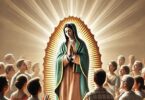
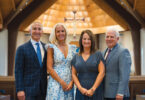
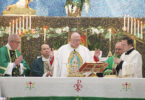
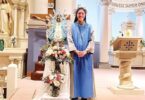
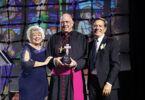
My Dad was one of the founding members of the St. Bridget Historical Society.
Good story Fr. Jim, I remember hearing parts of that story from Mom.